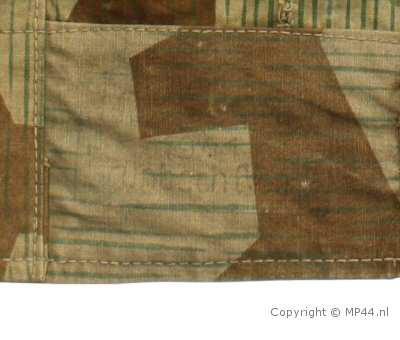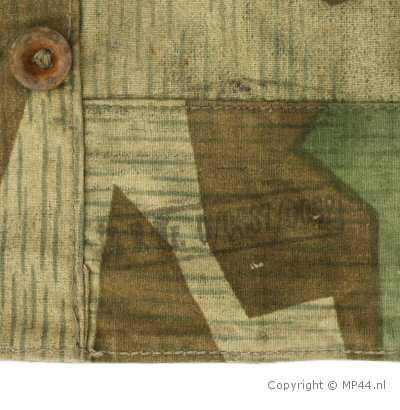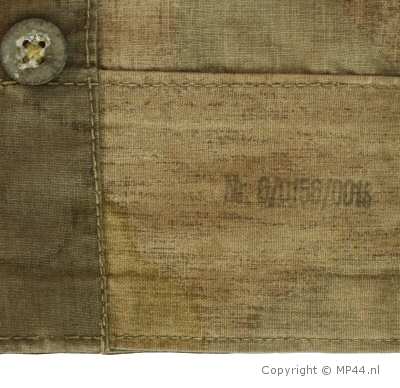The Zeltbahn 31 was developed and issued first in 1931 and found
its origin in the square Reichswehr tent.
The Zeltbahn was patented by Walter Reichert (Warei) in 1929.
It is made of a water repellent material called Makostoff and is
imprinted with a camouflage
pattern (developed in 1929) which is also known as Army Splinter Pattern (Heeres Splitter
Muster 31).
Another phrase used was: Buntfarbenmuster ("Splittertarn")
Basically the shelter quarter was
used for 2 purposes: to make a tent and as a rain poncho,
but the shelter quarter could be used for a variety of purposes as
explained in the official manual H.Dv. 205/1.
Below, a Zelt with its basic accessories and the H.Dv. 205/1 is shown
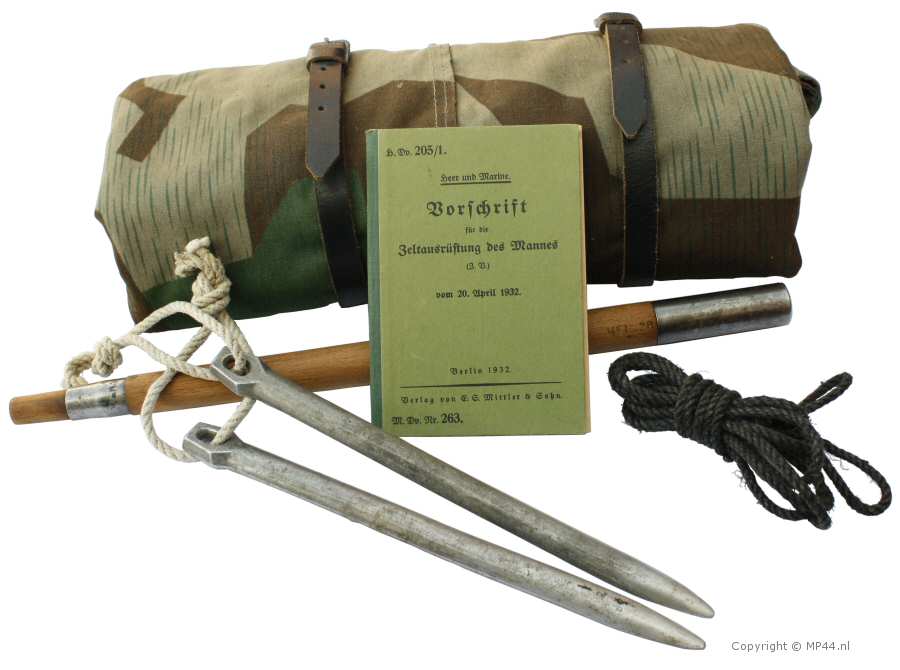
As shown below the shelter quarter
had 2 different colours on each side.
These colours are also called Hellerer Buntfarbenaufdruck and Dunklerer
Buntfarbenaufdruck.
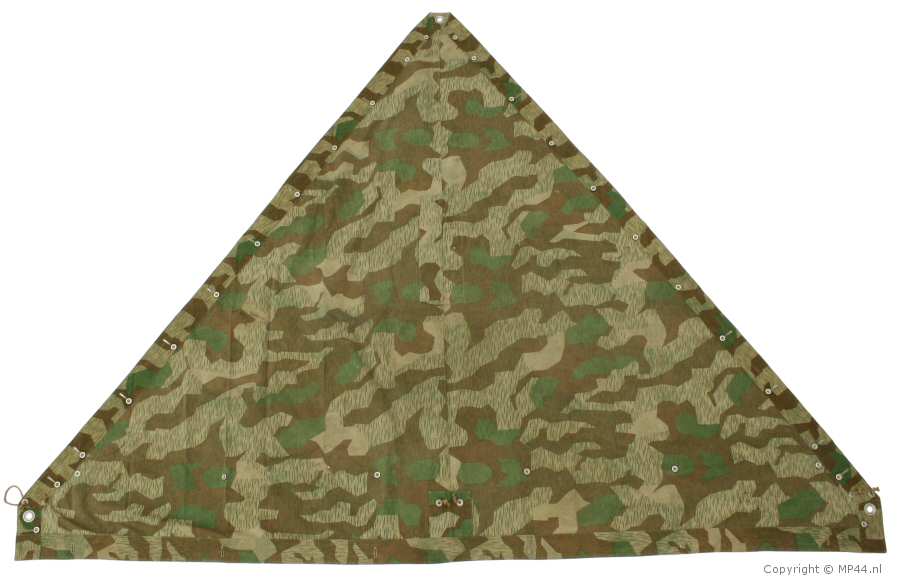
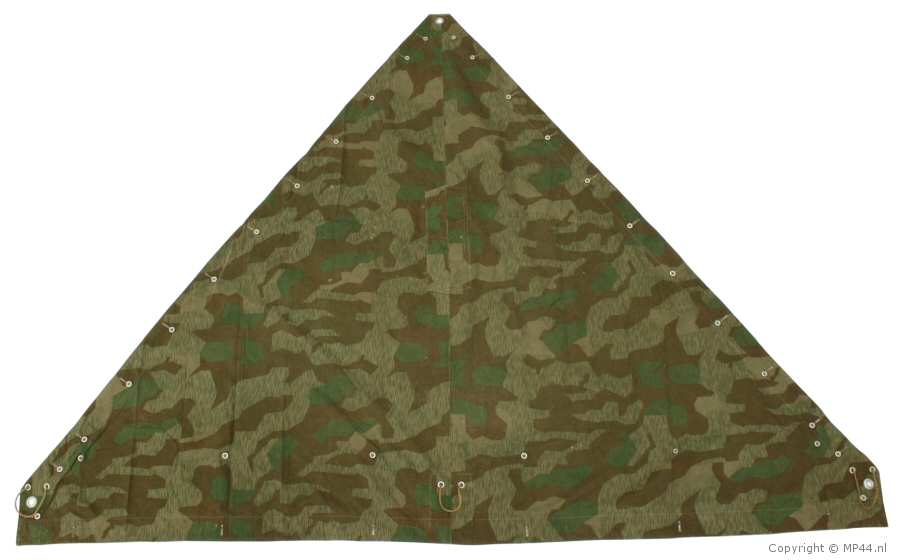
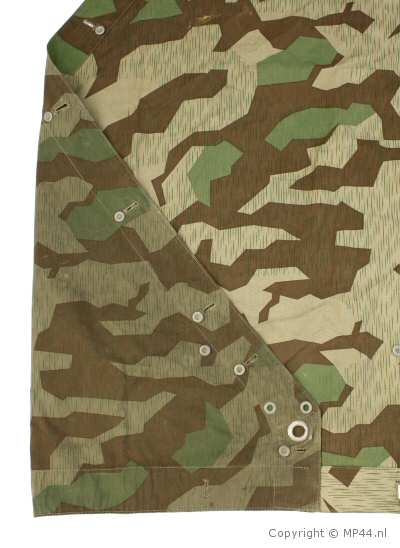
On the left, the two shades of a 1941 dated shelter quarter are shown.
A lot of different colour variations can be found.
This of coursse all depends on the wear and exposure to sunlight.
The dimensions of the triangular shelter quarter are 250 x 200 x 200 cm.
Each side had a row of 11 aluminium,
zink or steel buttons which are used to connect two shelter
quarters to eachother.
On the base 1 button, and a row of 6
buttons, are used to connect a tent made of four quarters (Viererzelt)
to a so called house tent (Hauszelt)
In the middle, there is slit (also with button) for the wearer's head when used as a poncho.
Below the dimension drawing from the Manual H.Dv. 205/1
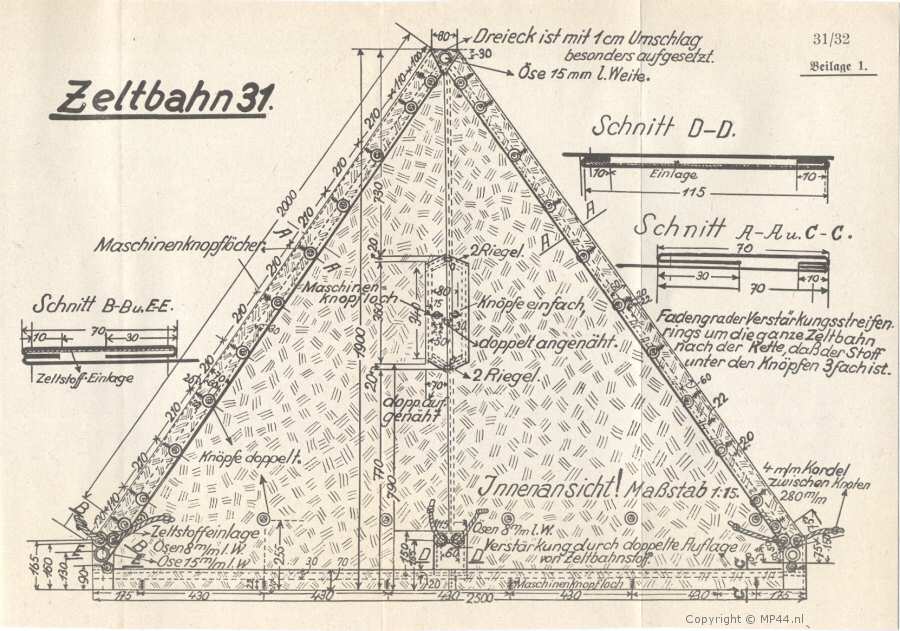
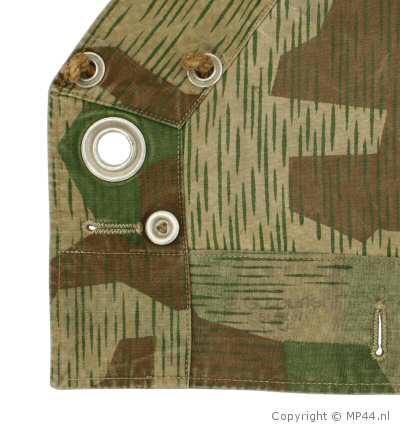
Left: detail of the lower corner.
Clearly shown are :
-
the two small (8 mm) gromets with rope (aprox 28 cm long)
-
the bigger (15 mm) gromet
-
3 holed aluminium button and buttonhole
-
maker mark is also visible

The front side of the same corner.

The makers stamp, unfortunately not too clear.
E.G. Leuner
Bautzen
1938
Below: the front and back side of the top part with 15 mm grommet
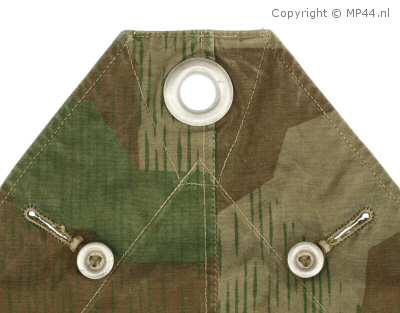
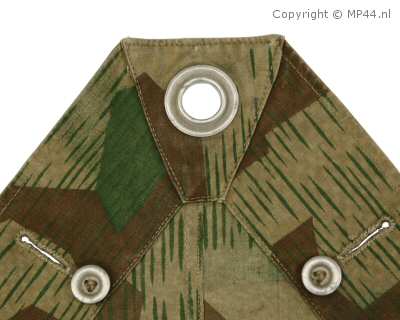
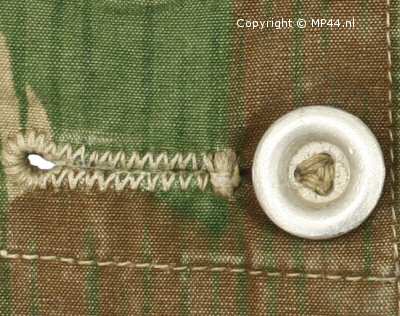
Detail of 3 hole zink button and buttonhole.
These buttons are all double sides which means
that there is also a button on the other side.
The official dimension drawings of the grommet ( Öse ) and button ( Knopf )

Detail of the lower middle part.
The reinforced part with the 8mm gromets and rope
are shown.Also shown are the buttons and button holes to form the "house tent"

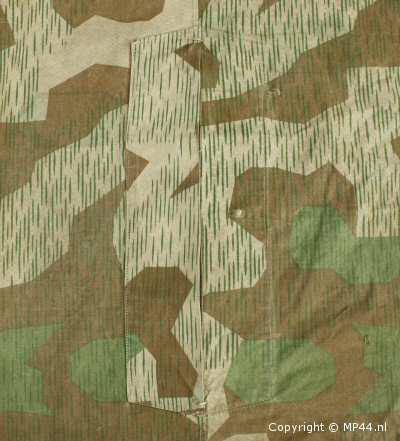
Detail of head opening (closed).
The head opening is aprox. 36 cm. and consists of a few layers
to make it waterproof when used as a tent.
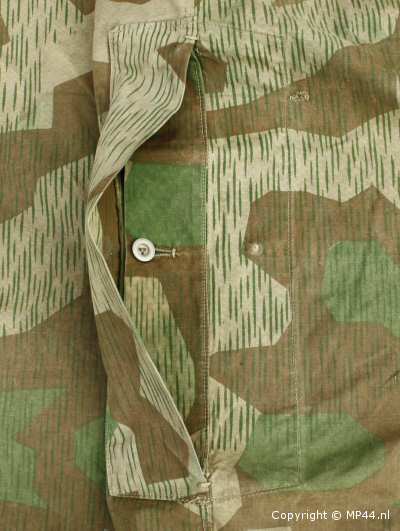
Detail of head opening (opened up one side).
This could also be buttoned up as can be seen.
note: these are one sided buttons.
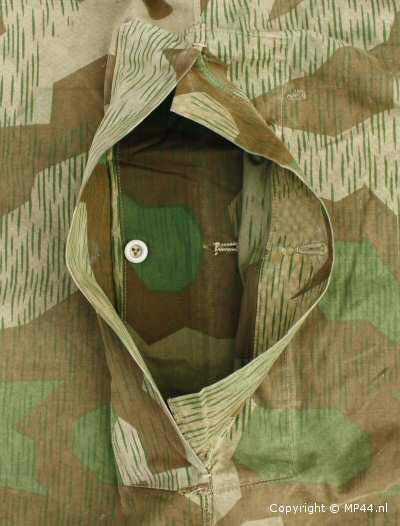
Now unbuttoned
The other side can be seen, which is also buttoned

Detail of head opening (opened up both sides).
A total of 4 layers which are buttoned upon each other,
this prevented the rain from pouring in when used as a tent.
Varieties
Of course, like with so many equipment items, varieties existed.
Throughout the war the Zeltbahn evolved (basically remaining the same)
early examples have aluminium
buttons and grommets, while later ones have zink and steel buttons and
grommets
Also the number of grommets was reduced around 1943.
The overview below will show a variety of Zelts which represents the important changes and varieties
- Light / Dark side with aluminium hardware (shown above)
- Light / Dark side with steel / zink hardware
- Single Grommets
- Same colour sides
- Brown / Ochre Camouflage
- Rotated Buttonholes
- Italian Camouflage
- Zelt made of 4 pieces
- Carbon Overprint
- Open Weave
- Reduced Pattern- Grey Zelt (paramilitary organisations)
Below the 1st alteration visible on a 1941 dated Zeltbahn
When the war started, soon all
aluminium hardware (buckles etc)
were replaced by zink and steel, and from 1941 on
allmost no aluminium was used for normal soldiers equipment.
On allmost all war time examples these zink and steel buttons can be found.

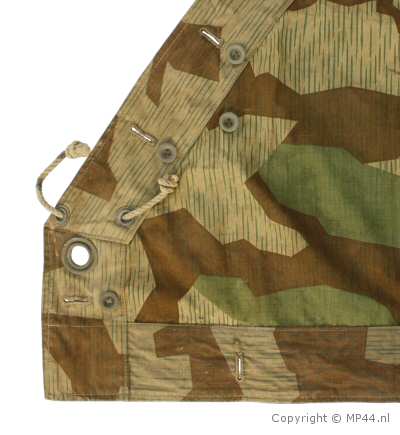
On the left detail of the zink buttons
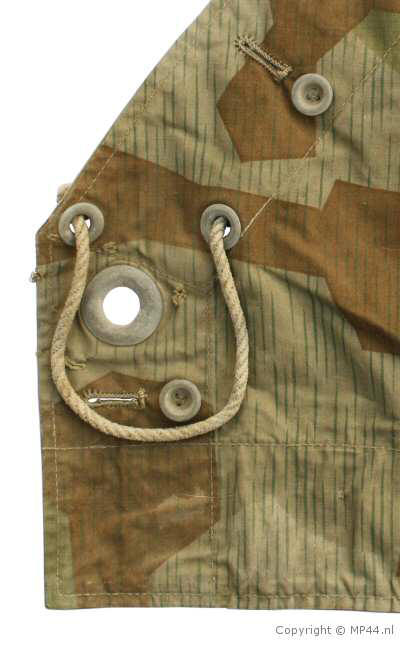
And even bigger detail of the darker side of the Zelt.
Below the maker mark (difficult to photograph)
Max Scheffel
1941
Grünbach (Vogtl.)
Another change was that in stead of 2 grommets only 1 was used.
This change set in at aprox 1943 but Zelts with 2 grommets dated 1944 can be found
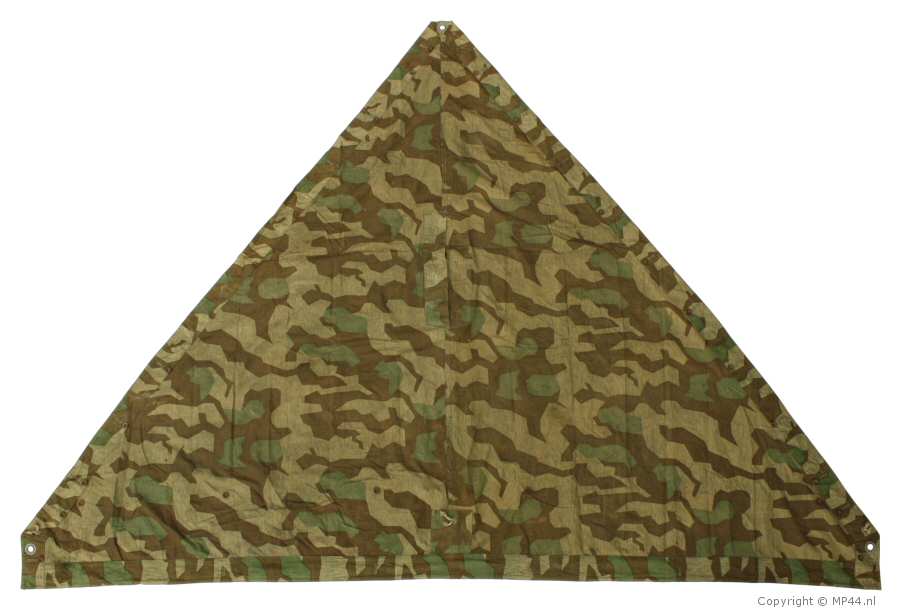

On the left the single (zink) grommet and steel buttons can be seen.
Below the maker mark which by 1943 was replaced by the RB. number
In this case R.B. Nr. 0/0337/0032
Also on the lower middle part a grommet was removed as can be seen below

Another Variation (not exactly known is
when they 1st were introduced) are the shelter quarters with identical
colours on the front and back side.
Below an example is shown
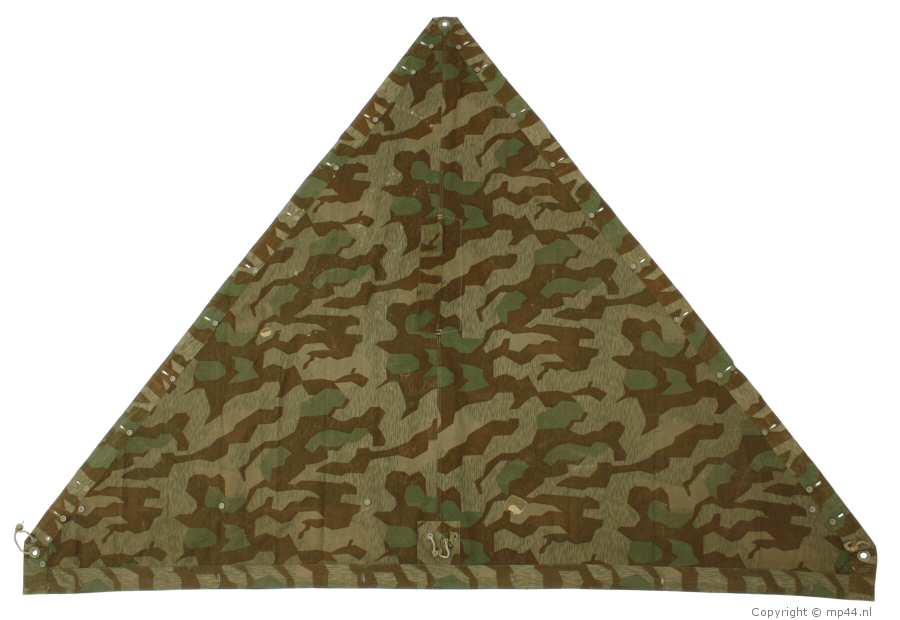
Here you see the left flap turned over
so the front and back side are both visible.
As can be seen the colours are the same
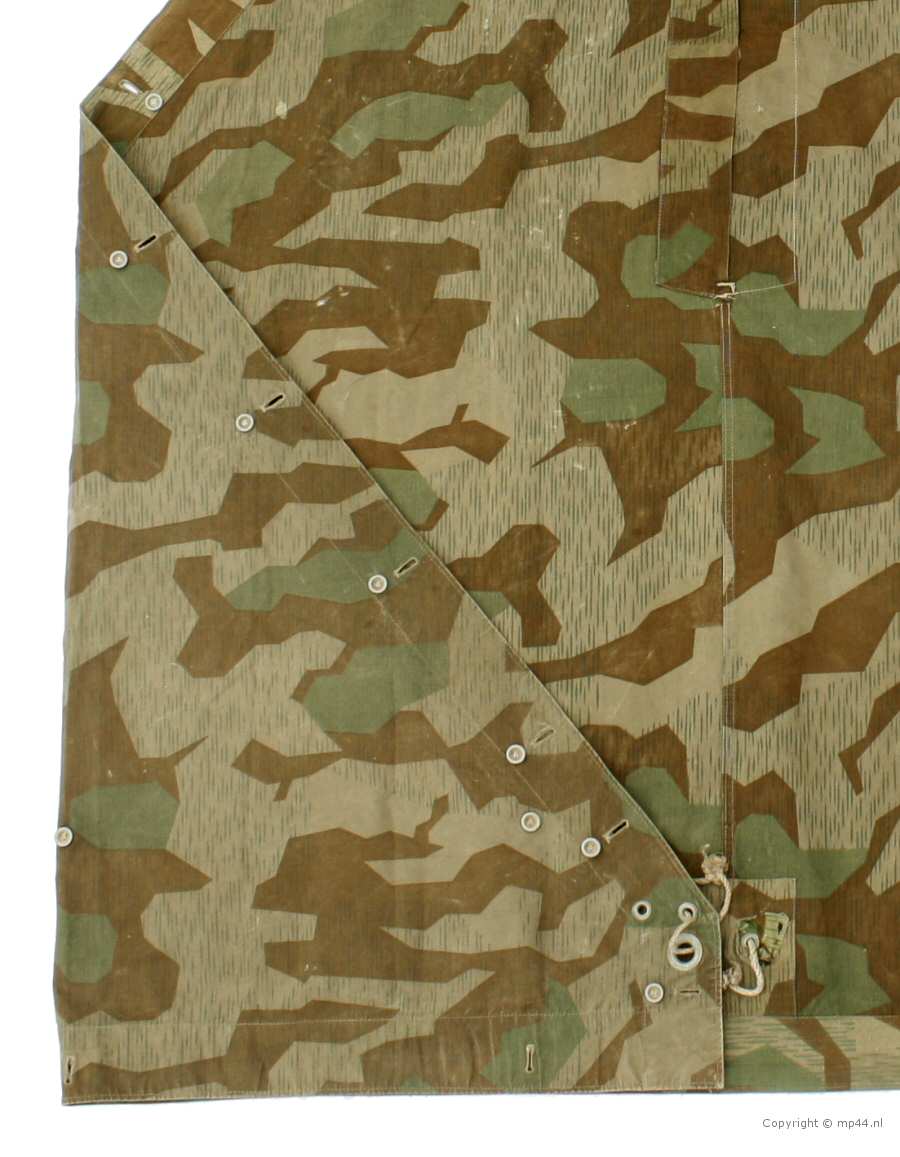
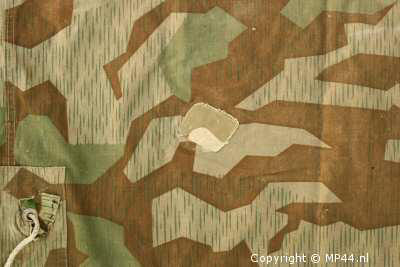
Also a nice detail on this Zelt is that the small repair is
made with italian shelter quarter fabric.The italian shelter quarter will be shown further down.
A vary nice variation is shown below,
but the reason why it was printed in these brown / ochre colours
still remains a mystery.
Apparently these Zelts were
produced from 1938 - 1942
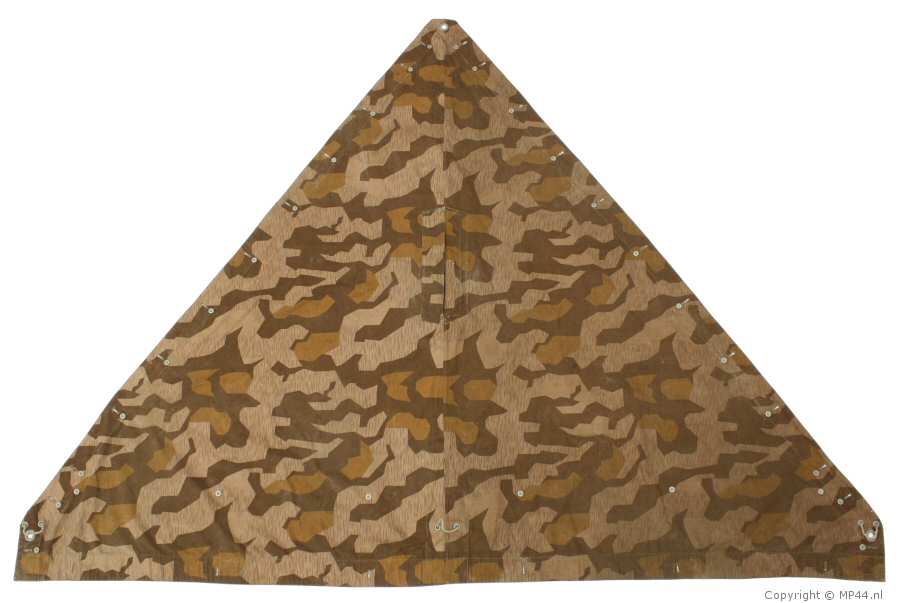
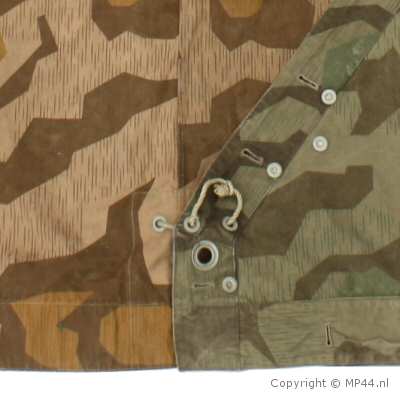
Most of the time these shelter quarters are without maker mark (like this example).But most of the time maker mark L. L. G. der Segelmacher, Berlin is encountered.
Below the flaps are folded inwards so
it is clearly visible that only one side is in the brown / ochre colours
The other side remains in the normal Splittertarnmuster.

The following variation was a shelter
quarter with rotated buttonholes and was made
to give the buttoned-up tents more stability. This alteration was documented
in HM 314 from May 15, 1944
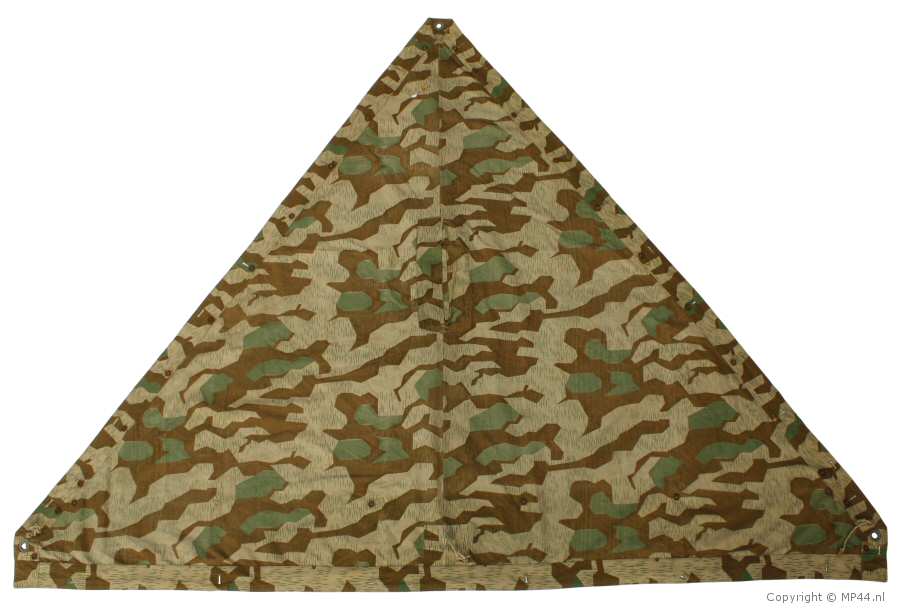
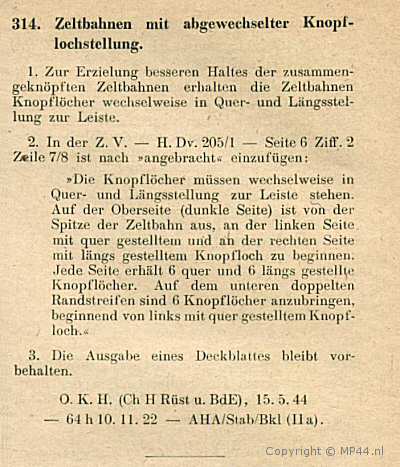
314. Shelter quarters with alternated buttonhole position.
1. To achieve a better balance in the buttoned-up tents, the shelter quarters receive buttonholes alternately in transverse and longitudinal position.
2. In the Z.V. -- H.Dv. 205/1 -- Page 6, Pos. 2, Line 7/8 is to be inserted after »installed«:
» The buttonholes have to be placed alternately in transverse and longitudinal position on the strip. On the upper side (dark side) is, seen from the top of the shelter quarter, on the left, started with a transversely placed buttonhole, and on the right with a longitudinal positioned buttonhole. Every side receives 6 transversely and 6 longitudinally placed buttonholes. On the lower edge dual strip is started with a transversely placed buttonhole, started from the left. «
3. The issue of a cover sheet remains reserved.
O.K.H. (Ch H Rüst u. BdE), 15 may 1944
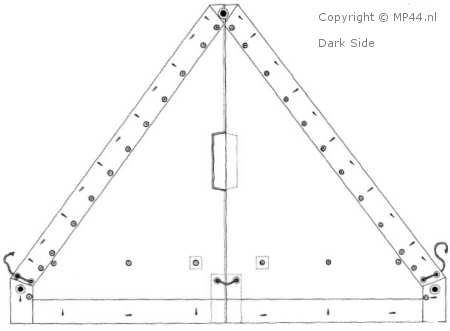
To make it a little easier to understand the
meaning of the H.M. a sketch of the alternate
buttons is shown on the left.
Below is a picture of the top of the dark half of the
shelter quarter which very clearly indicates the position
of the buttonholes.

This alteration, however, did not last very long and was nullified by the following order HM 403 from July 8, 1944
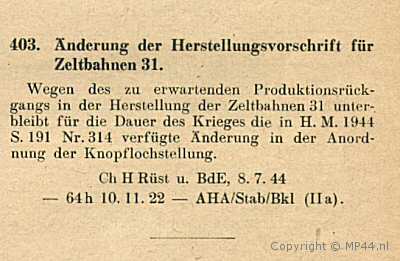
403. Change of the manufacturing regulations for
Shelter Quarter 31.Due to the anticipated production decrease in the manufacturing of the Zeltbahn 31, the change in the positioning if the buttonholes as mentioned in H.M. 1944 Page 191 No. 314, is omitted.
Ch H Rüst u. BdE, July 8, 1944
Due to the capitulation of the italian
armed forces in 1943, a lot of italian stock came in
the hands of the german forces who occupied Italy.
These stocks of material were widely used by germany because of the increased demand for equipment.
Amongst other things, italian camouflage fabric was used to create shelter quarters
These shelter quarters are made in 4 pieces probably because the rolls of italian fabric were smaller.
An example of such an Italian Zeltbahn is shown below.
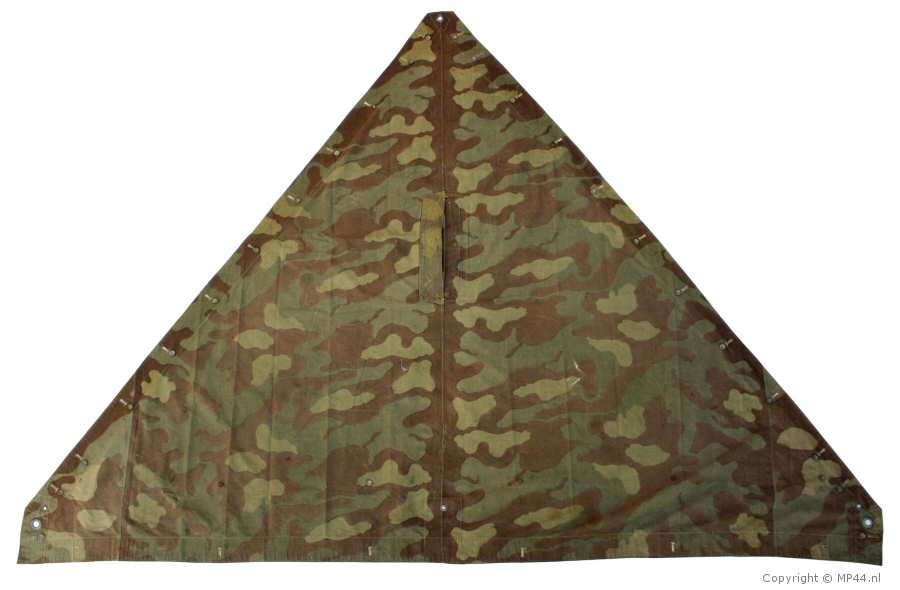
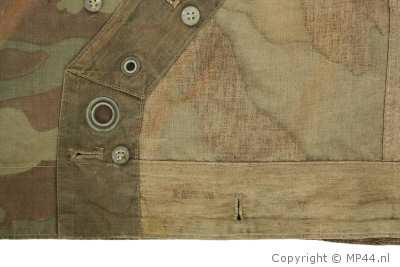
As can be seen on the left, the other side of the Zelt is unprinted !

Detail shot of the corner with the maker mark
On the italian Zelts often 4 hole buttons are encountered
( probably also captured italian material )
Below the manufacturer number (RB 0/0156/0018)
As can be seen here, also normal german camouflage material was used.

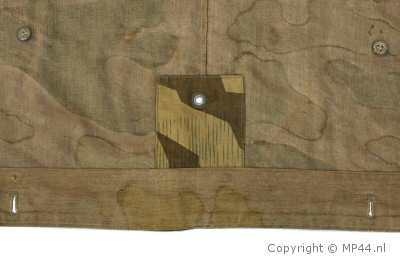
Also the reinforcent of the lower middle grommet
is made of normal Splittermuster material.
One of the last changes / alterations was the so called Carbon Overprint (COP ) as shown below
Another feature on this shelter quarter is the fact that it is in 4 pieces (like the italian one)
The carbon overprint was made to deter the infra red devices developed in the end of the war.
Although the COP is very faded it still can be seen. Shelter quarters with this overprint are very rare.
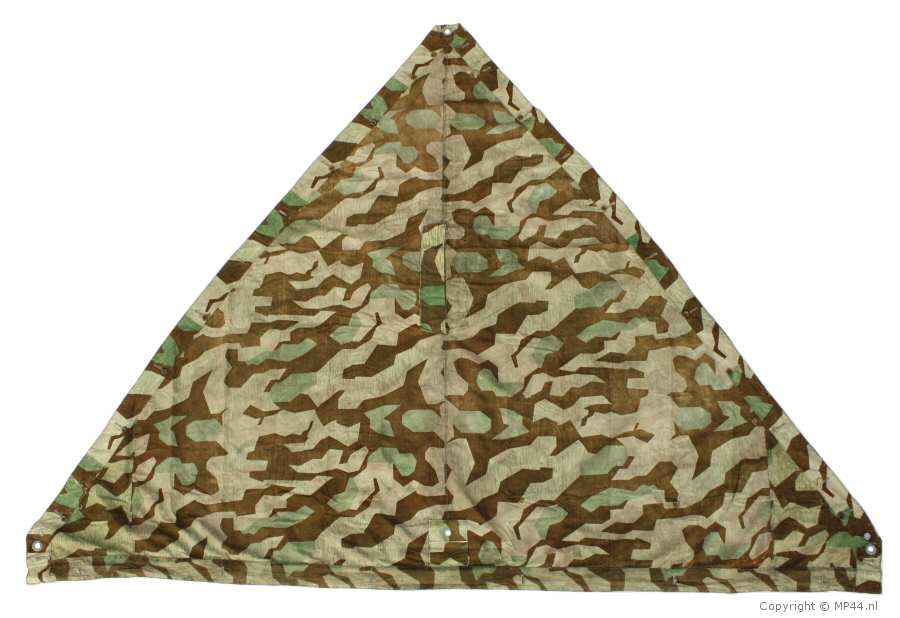
On the detail picture below the Carbon Overprint can be easily seen.
The COP has rounded corners and probably is printed with the same presses as the italian fabric is printed.
Also the small corner which is added can be seen here.
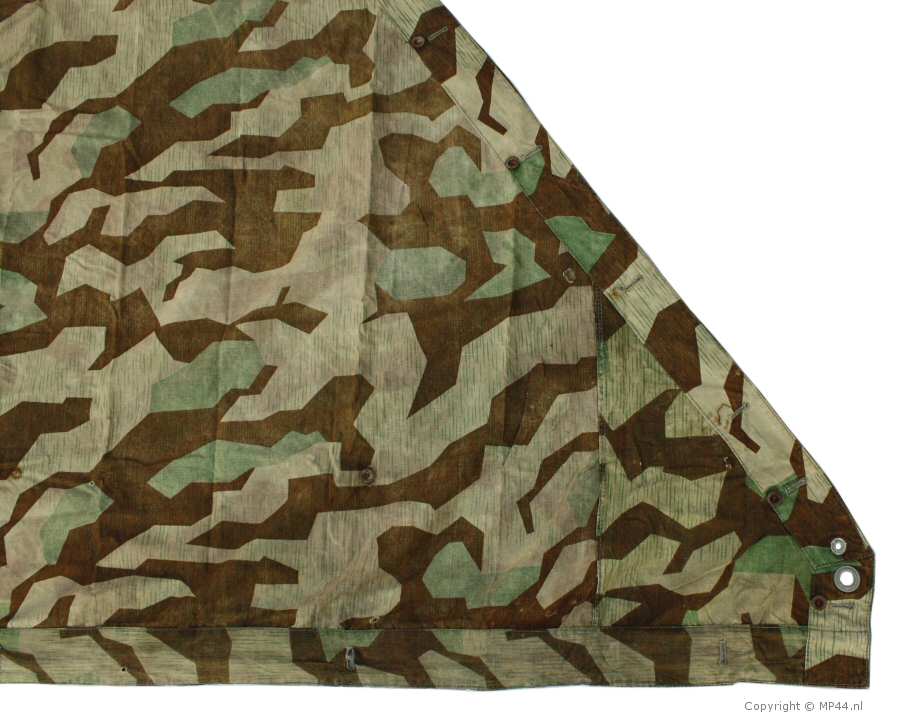
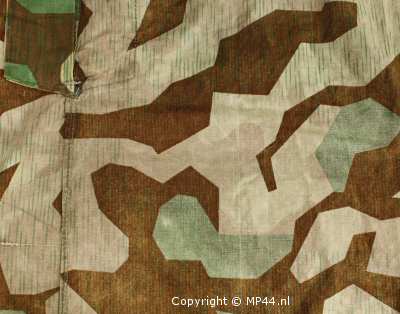
Left: The rounded form of the COP can be seen here
Another feature that can be encountered is the so called "Open Weave"
The open weave print is shown below on a Zelt which has another strange feature: no gromets !
Maybe these shelter quarters were only
intended as a rain cape and not as a Zelt but there is no proof to
back this up.
Is also is possible that it is just an unfinished example.

Below the difference between the open weave and normal print.
When comparing the "rain drops" one can
seen that the normal print
has straight lines while the open weave is more irregular
Below: Open Weave

Below: Normal Print

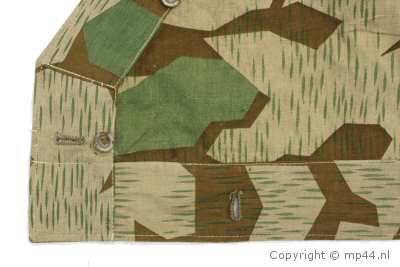
On the left a detail pic with the missing gromets
A very rare variety is the so called "reduced pattern"
Until recent these were defined as post war french, but they are definately german !!
Below an example (4 piece-Zelt) of the reduced pattern
* note * :
No doubt the new book "History of the German "Zeltbahn" 1925 -
1945 from Mark Steacy and Werner Palinckx will
shed some new light on these
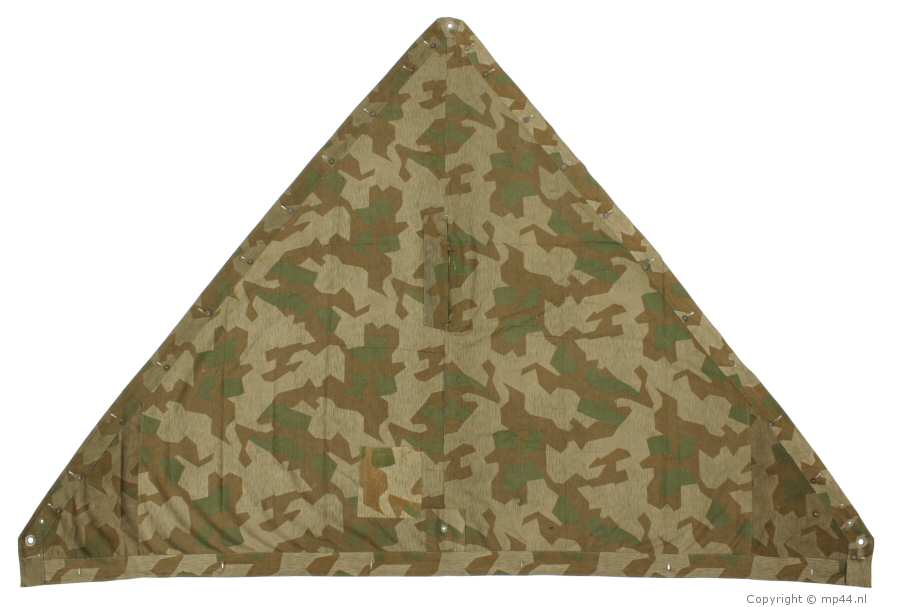
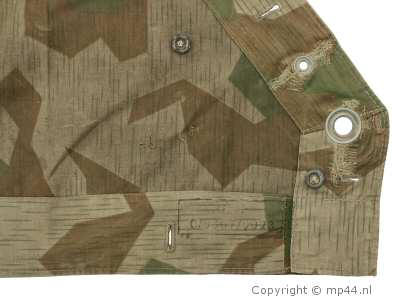
Left: the lower right corner with the maker mark
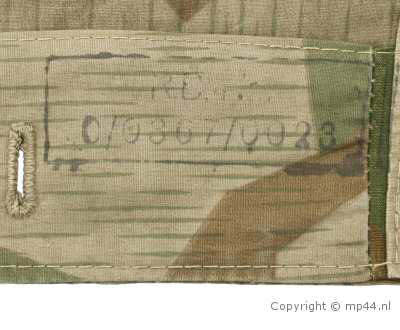
Detail of maker mark
RB. Nr. 0/0367/0023
Below: the darker side of the Zelt which also shows the reduced pattern.
Also visible a repair which has been made with the same cloth
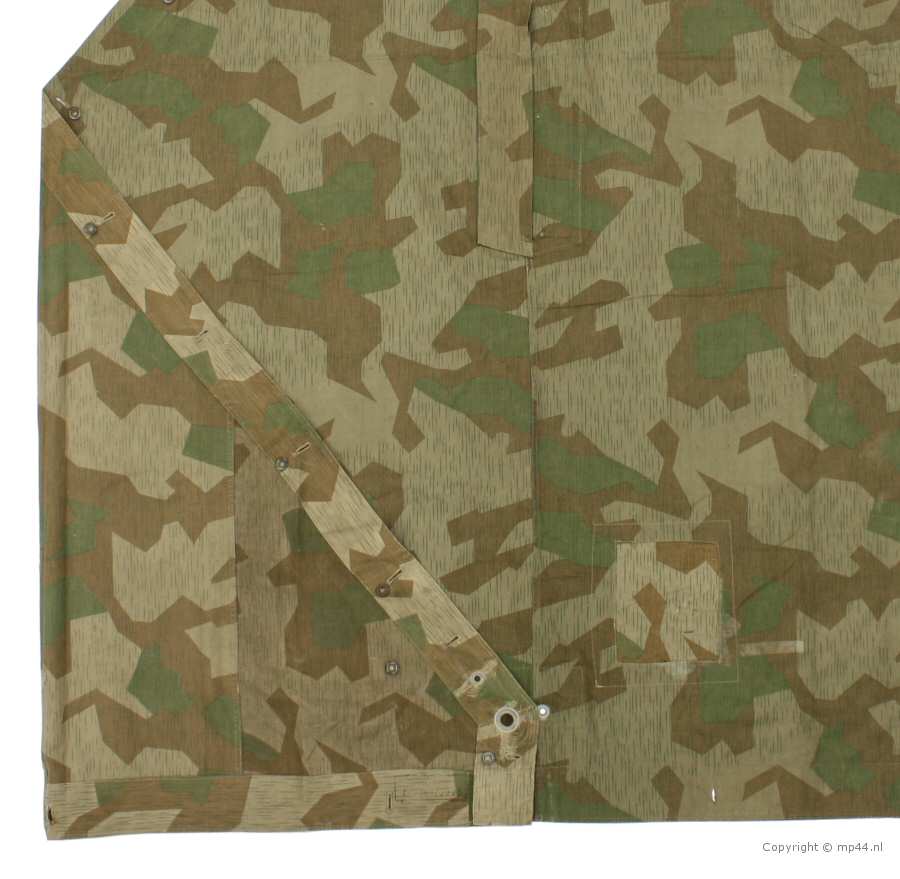
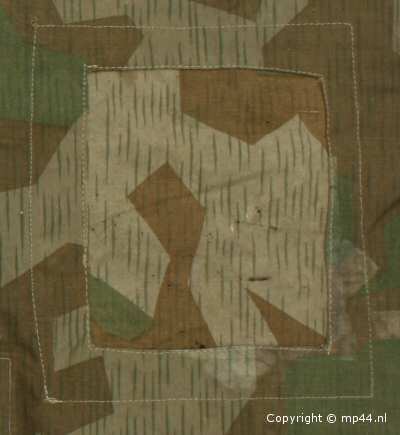
Left detail picture of the repair.
Not really a variety but nonetheless important, the brown / grey shelter quarter is shown
These single colour shelter quarters
are generally believed to be issued to
paramilitary organisations such as TeNo (Technische Nothilfe) , R.A.D.
(Reichs Arbeitsdienst), H.J. (Hitler Jugend) and so on
Below an example of the TeNo which is entirlely grey and comes with Aluminium Hardware
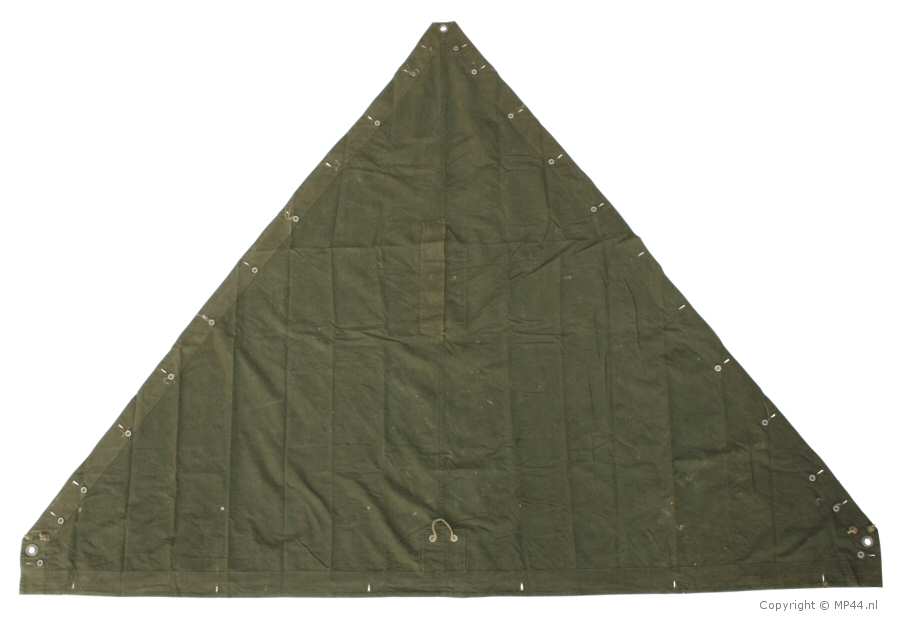
Below, the TeNo shelter is shown next to another plain grey/brown shelter (probably R.A.D.)
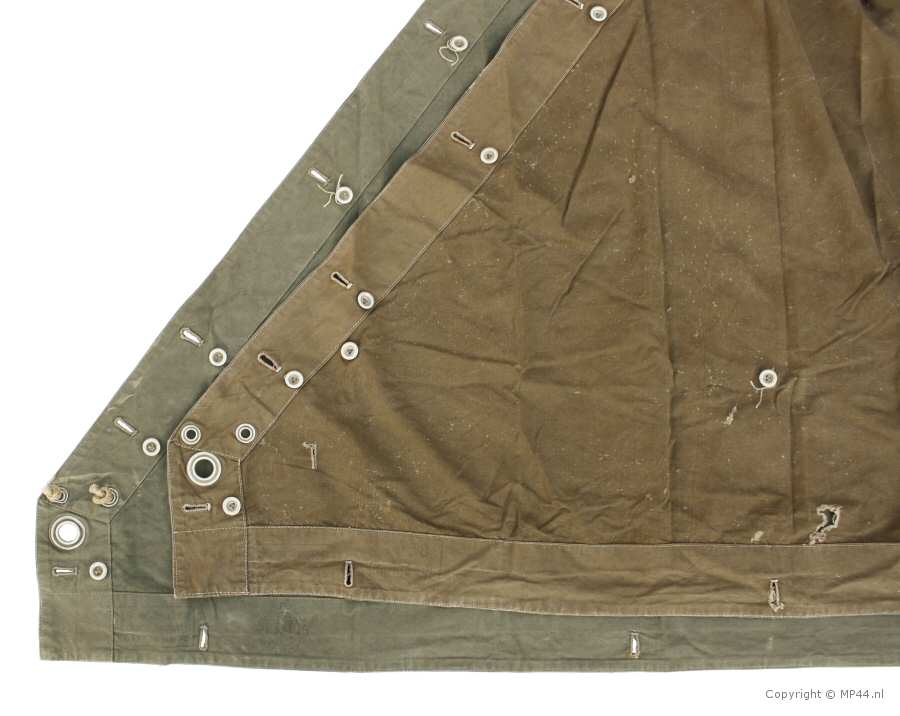
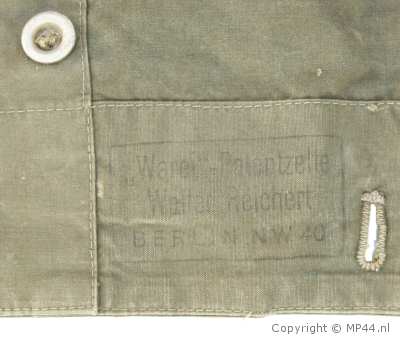
Left the maker mark (in the left corner)
"Warei" - Patentzelte
Walter Reichert
BERLIN NW 40NW 40 stands for a district in Berlin and does not stand for the date
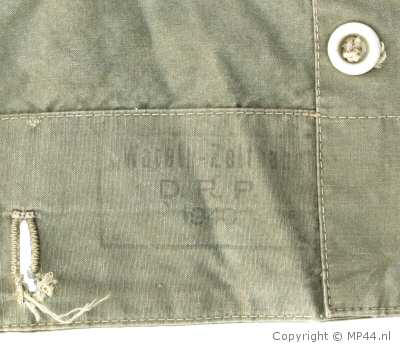
On the right side of the shelter this maker mark can be found:
Warei - Zeltbahn
D.R.P.
1940D.R.P.stands for Deutsches Reichs Patent
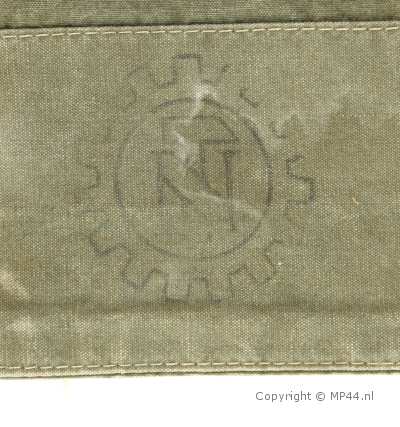
On the left, the TeNo (Technische Nothilfe) symbol
The following sections will explain the accesories, usage and methods of wearing the shelter quarter
